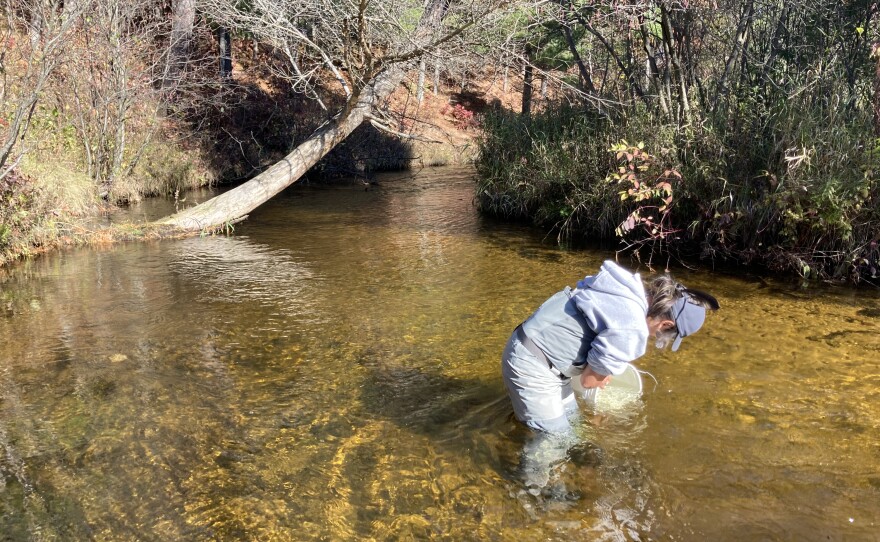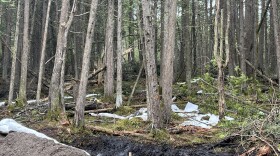On a sunny morning in late October, 557 silvery-blue speckled fish seem to be taking in their surroundings along a secluded branch of the Boardman-Ottaway River.
They swim out of a bucket, point their heads upriver, hover for a moment in the current and then disperse. For what's likely the first time in more than a century, Arctic grayling are swimming in the Boardman-Ottaway River.
These fish join hundreds of others which were released in August. Now, it's a waiting game: It will be at least three years before scientists can tell whether the fish have survived and returned to this part of the river to spawn.
This release is part of a years-long effort led by the Grand Traverse Band of Ottawa and Chippewa Indians to restore the Boardman-Ottaway River. It began with dam removal more than 10 years ago and has since moved on to rearing and releasing native species like lake sturgeon and Arctic grayling, whose numbers plummeted after habitat destruction due to logging, overfishing and competition from non-native species.
Arctic grayling used to be abundant in Michigan's rivers, so much so that the City of Grayling took its name from the iridescent fish. But they haven't been seen in the Lower Peninsula since the early 1900s. Previous attempts to reintroduce them have failed.
But with dams gone, rearing techniques honed and the completion of FishPass in sight, scientists are hoping this time will work.
Alaska to Kalkaska
Arctic grayling are native to the waters of Arctic Canada, Alaska, Montana and Michigan. Now, only two remnant populations exist in the Lower 48, both in Montana.
Grayling eggs were first brought from the Chena River in Alaska to a DNR hatchery in northern Michigan around five years ago. That brood stock is where three tribes in northern Michigan sourced eggs from earlier this year.
The Little Traverse Bay Bands of Odawa Indians released grayling into the Maple River near Petoskey; the Little River Band of Ottawa Indians released them into the Manistee River near Kalkaska and the Grand Traverse Band of Ottawa and Chippewa Indians released them into the Boardman-Ottaway River outside Traverse City.
The Grand Traverse Band used a technique developed by scientists who successfully reintroduced grayling in Montana, called stream side rearing.
"It's an experiment. We don't know if it's going to work," said Dan Mays, a biologist with the Grand Traverse Band, in an interview with IPR earlier this year. "We're going to be imprinting these fish ... raising them in the waters where they're going to be released, so they get acclimated to the water conditions. They hone in on the chemical cues in the water, so hopefully they return to those same sites to reproduce."
Water was trucked in from the carefully-selected portion of the Boardman-Ottaway River where the grayling would eventually be released. The eggs were hatched in tanks full of that water and spent the first few weeks of their life in it — all in a trailer along the banks of the river.
Divas of the stream
Earlier this summer, several thousand grayling were released at a much younger age into the Maple and Manistee Rivers.
Grand Traverse Band biologists are experimenting with whether slightly older fish might have a better chance of survival: hundreds were released in August. The final batch — in which fish had grown to about six inches — was released last week.
The small fish had the first hints of their famously flashy, sail-like dorsal fins.
"In our stories, we talk about them kind of having a diva attitude," said Tera John, a tribal member, story keeper and educator with the Grand Traverse Band. "So when I see them, I see their sails and their iridescence. They're beautiful, they're kind of skittish and when they're young ... they're really fickle. They're like, 'Don't look at me wrong. I will die.'"
But many managed to survive the six months of rearing, growing big enough for biologists to insert a tag, which allows them to track the location of the fish at certain points in the river.
What to do if you find a grayling
If caught, Arctic grayling must immediately be released. Take note of adipose fin and contact the Grand Traverse Band Natural Resources Department at 231-534-7500. An unclipped fin indicates summer release, whereas clipped indicates fall.
Before the final release in October, biologists measured and weighed the grayling, then transported from the stream side rearing facility to the release site.
"We electro-fished eight different tributaries, 16 different sites," said Dan Mays. "Based on habitat and the fish community and the water temps, this ranked the highest for grayling for reintroductions."
Tera John waded into the river and released the fish bucket by bucket.
"When they're coming back out here and smelling their river that they're essentially smelling since birth, it's a threshold moment," she said. "It's like maybe stepping out in the spring from a stuffy building, smelling all of those smells come to life. Or coming home to your home-cooked meal that smells like home. I wonder if that's what it smells like."
Aaron Chivis, who leads the Grand Traverse Band's cultural department, joked from the riverbank: "[It] could smell like fish poop, just saying. Always a possibility."
Regardless of what those fish are smelling, they're back in the Boardman-Ottaway River, after years of efforts by tribal, state and federal natural resources agencies.
Now, the grayling have to clear two final hurdles, maybe the hardest ones yet: survive, and spawn.




![A young Arctic grayling is weighed prior to release. "In our stories, we talk about [grayling] kind of having a diva attitude," said Tera John, a tribal member, story keeper and educator from the Grand Traverse Band. "They're beautiful, they're really kind of skittish and when they're young ... they're really fickle. They're like, 'Don't look at me wrong. I will die.'" (Photo: Ellie Katz/IPR News)](https://npr.brightspotcdn.com/dims4/default/b87d18c/2147483647/strip/true/crop/4032x2483+0+270/resize/880x542!/quality/90/?url=http%3A%2F%2Fnpr-brightspot.s3.amazonaws.com%2F43%2F52%2Fb09872de492b90c17fd9f376801b%2Fimg-4135.jpg)







